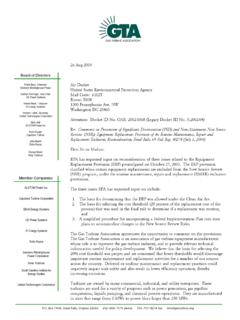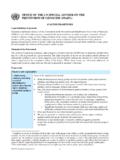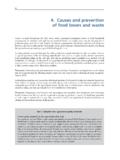Transcription of GreenChill Best Practices Guideline: Commercial ...
1 EPA 430-B-11-001 GreenChill best Practices Guideline Commercial Refrigeration Leak prevention & Repairs Environmental Protection Agency Stratospheric Protection Division May 2011 i DISCLAIMER This document does not address or assert compliance with the statutory requirements of Section 608, Title VI of the Clean Air Act, as amended in 1990. Nor does this document address or assert compliance with the EPA Section 608 leak repair regulations, at 40 CFR Part 82, Subpart F. The authors of this Guideline, and the companies, agencies, and organizations to which they belong, do not assume responsibility for any omissions or errors, or assume liability for any damages, that result from the use of this Guideline.
2 Always check with your equipment manufacturers for proper procedures for your equipment before undertaking any action that may affect your equipment. ii TABLE OF CONTENTS I. INTRODUCTION .. 1 Mission .. 1 Purpose and Scope .. 1 Refrigerant Leaks from Supermarket Refrigeration Systems .. 2 II. WHY SYSTEMS LEAK .. 3 Where Leaks Occur .. 3 Compressor Racks .. 3 Display Cases .. 4 Remote Air-Cooled Condensers .. 4 Walk-In Evaporators .. 5 Field-Installed Piping .. 5 Condensing Units .. 5 Remote Headers .. 5 Causes of 6 III. GETTING STARTED .. 9 No-Tolerance Policy .. 9 Tracking Leaks .. 9 IV. PREVENTIVE MAINTENANCE Practices .. 10 Clean Equipment .. 10 Leak Detection Alarm Systems.
3 11 Regular Leak Inspections .. 11 V. LEAK REPAIRS .. 12 Response Time .. 12 Thoroughness of the Check .. 12 Follow Up Checks and Verification .. 12 VI. REDUCING LEAK POTENTIAL .. 13 Overcharged Systems .. 13 System Component Upgrades .. 13 Additional Recommendations .. 13 APPENDIX A. SUPERMARKET WALK-THRU CHECKLIST .. 15 APPENDIX B. MONTHLY REFRIGERANT RECEIVER LEVEL CHART 2011-2012 . 17 1 I. Introduction Mission GreenChill s mission in developing this document is to assist food retailers in reducing refrigerant leaks in their Commercial refrigeration systems. Purpose and Scope The purpose of this best Practices Guideline is to provide food retailers with information on best Practices for reducing refrigerant leaks from Commercial refrigeration systems.
4 The Guideline only covers Practices implemented during the design and operation of a refrigeration system and does not discuss leak prevention Practices during the installation of equipment. Information on leak-tight installations can be found in GreenChill s best Practices Guideline: Ensuring Leak-Tight Installations of Refrigeration While GreenChill preferably encourages the adoption of advanced refrigeration as a means for reducing refrigerant emissions, the partnership also recognizes the importance of proper servicing and maintenance Practices in refrigeration management strategies. This Guideline document focuses on Practices largely relevant to traditional centralized direct expansion (DX) systems; however, most Practices also are applicable to other system types such as distributed systems and secondary loop systems.
5 Specifically, the Guideline provides information on the following: Why systems leak; Tracking refrigerant charges; Preventative maintenance Practices ; Responding to leaks; and Reducing leak potential. This Guideline document does not address compliance issues associated with EPA regulations promulgated under Title VI of the Clean Air Act, as amended in 1990, including the regulatory leak repair provisions under Section 608 of the Clean Air Act. 1 Available at 2 Table 1: ODP and GWP of Common Refrigerants Refrigerant ODP GWP CFC-12 1 10,900R-502 4,646 HCFC-22 1,810 HFC-134a 0 1,430R-404A 0 3,922R-507A 0 3,985R-407A 0 2,107R-410A 0 2,088R-744 (CO2) 0 1 Source: IPCC (2007), Montreal Protocol Refrigerant Leaks from Supermarket Refrigeration Systems Traditionally, supermarket refrigeration systems are characterized by large refrigerant charge sizes and potentially high leak rates, a combination that results in considerable refrigerant emissions.
6 EPA estimates that a centralized DX system can emit as much as 25% of its refrigerant charge However, through best Practices and the adoption of advanced technologies, GreenChill members have shown considerable success in reducing refrigerant leak rates. In 2008, GreenChill partners collectively reported an average corporate-wide annual emission rate of 12%.3 Individual partners have also shown that greater leak reduction is possible, setting aggressive corporate emission targets of less than 7%. Furthermore, individual stores have proven that rates less than 5% are achievable and sustainable with the adoption of advanced refrigeration technologies in combination with best Practices .
7 To encourage supermarkets to reduce leaks, it is first important for supermarkets to recognize the negative impact refrigerants have when emitted into the atmosphere. Commonly used Commercial refrigerants such as chlorofluorocarbons (CFCs) and hydrochlorofluorocarbons (HCFCs) contribute to deterioration of the stratospheric ozone layer. CFCs, HCFCs, and even the ozone-friendly hydrofluorocarbons (HFCs) contribute to climate change. Table 1 summarizes the ozone depletion potential (ODP) and global warming potential (GWP) of commonly used Commercial refrigerants 2 See 3 The GreenChill partner emission rates described here are calculated according to the methodology in GreenChill 's program guidance, which uses the ratio of emissions during one year to the system s refrigerant charge.
8 See . This differs from the definition of leak rate in 40 CFR used to assess compliance with EPA s regulations. The regulatory definition expresses leak rate in terms of the percentage of an appliance s full charge that would be lost over a 12-month period if the current rate of loss were to continue over that period. 3 II. Why Systems Leak Where Leaks Occur Leaks can occur in a variety of locations throughout a supermarket. Figure 1 provides estimates from one regional supermarket chain of the portion of refrigerant leaks coming from specific sources. Each leak source is explained further below. Figure 1: Leak Sources for a Regional Supermarket Chain Compressor Racks A typical supermarket in the contains 2-4 parallel compressor racks, each with a number of rack-mounted components that are all potential leak sources.
9 Components include 3-8 compressors; suction, liquid, and discharge manifolds; suction control valves; 3-way valves; head pressure controls; suction filters; liquid driers and sight glasses; a liquid receiver; an oil separator; a suction accumulator; pressure controls; and numerous shut-off valves. Prime locations for leaks include: Pressure controls and their control lines or cap tubes, from vibration, rub-through, or mechanical damage; Rack-mounted valves, including o Brazed or mechanical fittings, flanges, and threaded pipe fittings on the receiver; o Valve stem packing, especially if the valve cap and/or cap seal is missing; o Control lines, especially high-pressure lines; and o Access ports; Filter/drier assemblies, from deteriorated gaskets or loose flange bolts; Manifold tee fittings that are improperly brazed from the factory and subject to vibration from the rack; Receiver liquid level gage ports, which leak from deteriorated gaskets.
10 Schrader valves, through their cores, especially if the cap is missing; and 4 Steel components such as suction accumulators, suction filter shells, steel suction valves mounted on the suction line, and even receivers mounted below a suction manifold due to corrosion, as seen in Figure 2. Figure 2: Excessive corrosion on rack components Display Cases An average-sized supermarket can contain over one hundred display cases. The potential for leaks from display cases is great, due to the large number of leak points in the evaporators and expansion valves. Evaporator coils are made up of small-diameter tubing and many soldered return bends, making them susceptible to leaks.














